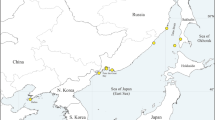Summary
Six small cells are present in each of the bilateral gonads of parthenogenically reproductive Lepidodermella squammata. Early in the extended postparthenogenic phase of the life history, these cells undergo limited proliferation followed by differentiation. Primary oocytes of three types are present 0.3 days after deposition of the final parthenogenic egg: small oocytes with presynaptic nuclei; intermediate oocytes with nuclei containing synaptonemal complexes; and larger oocytes with a germinal vesicle. Oocytes persist without further development at least until day four of the postparthenogenic phase. Older isolated animals may contain and even deposit an enlarged egg, but successful progeny does not result. Oocytes are located at the anterior pole of each of the bilateral gonads, adjacent to developing male tissues producing sperm. More posterior cells in the gonad are initially undifferentated in the postparthenogenic phase. Dorsal and central cells first show specialization for secretory activity, and by day four contain peripheral layers of RER and central accumulations of polymorphic secretion droplets. The posterior and ventral cells produce secretion droplets that aggregate into an enlarging bilobed structure called the X-body. Two or three cells in each gonad contribute secretions to the X-body, which is intracellular in a secondary syncytium formed by the contributing cells. Functions for the postparthenogenic gametes and for the X-body are not yet demonstrated.
Similar content being viewed by others
References
Amato AJ, Weiss MJ (1982) Flexibility in the cuticular pattern of a cell-constant organism, Lepidodermella squammata. Trans Am Microsc Soc 101:229–240
Barnes RD (1980) Invertebrate zoology, 4th ed. Saunders College/Holt, Rinehart and Winston, Philadelphia 1089 pp
Hummon MR (1981) Spermiogenesis in a freshwater gastrotrich, Lepidodermella squammata. Ohio J Sci 81 (Suppl): 14 (abstract)
Hummon MR (1982) Parthenogenesis, sexual development, and aging in the freshwater gastrotrich Lepidodermella squammata: a cohort and ultrastructural study. PhD thesis, Ohio University, Athens 243 pp
Hummon MR (1983) The peculiar sperm of the freshwater gastrotrich Lepidodermella squammata: fine structure and speculations on function. Ohio J Sci 83 (2):1 (abstract)
Hummon MR (1984a) Reproduction and sexual development in a freshwater gastrotrich. 1. Oogenesis of parthenogenic eggs (Gastrotricha). Zoomorphology 104:33–41
Hummon MR (1984b) Reproduction and sexual development in a freshwater gastrotrich. 2. Kinetics and fine structure of postparthenogenic sperm formation. Cell Tissue Res 236:619–628
Hummon MR, Hummon WD (1984) Gastrotricha. In: Adiyodi KG, Adiyodi RG (eds) Reproductive biology of invertebrates, Vol. VI, Asexual propagation and reproductive strategies. Wiley, London (in press)
Hummon WD (1966) Morphology, life history, and significance of the marine gastrotrich, Chaetonotus testiculophorus n. sp. Trans Am Microsc Soc 85:450–457
Hummon WD, Hummon MR (1983) Gastrotricha. In: Adiyodi KG, Adiyodi RG (eds) Reproductive biology of invertebrates, Vol. I, Oogenesis, oviposition and oosorption. Wiley, London pp 111–121
Kisielewska G (1981) Hermaphroditism of freshwater gastrotrichs in natural conditions. Bull Acad Polon Sci, Ser Sci Biol, Cl II, 29:167–172
Levy DP, Weiss MJ (1980) Sperm in the life cycle of the freshwater gastrotrich, Lepidodermella squammata. Am Zool 20:749 (abstract)
Pennak RW (1978) Freshwater invertebrates of the United States, 2nd ed. Wiley, New York 803 pp
Remane A (1936) Gastrotricha. In: Bronn HG (ed), Klassen und Ordnungen des Tierreichs, Band 4, Abt II, Buch 1, Teil 2, Lieferung 1–2, Akad Verlagsges, Leipzig pp 1–242
Remane A (1967) Gastrotricha. In: Illies J (ed) Limnofauna Europaea, Gustav Fischer, Stuttgart pp 69–72
Ruppert EE (1977) Zoogeography and speciation in marine Gastrotricha. Mikrofauna Meeresbodens 61:231–251
Ruppert EE (1979) Morphology and systematics of the Xenotrichulidae (Gastrotricha, Chaetonotida). Mikrofauna Meeresbodens 76:1–56
Sacks M (1955) Observations on the embryology of an aquatic gastrotrich, Lepidodermella squammata (Dujardin 1841). J Morphol 96:473–495
Weiss MJ, Levy DP (1979) Sperm in “parthenogenetic” freshwater gastrotrichs. Science 205:302–303
Weiss MJ, Levy DP (1980) Hermaphroditism and sperm diversity among freshwater Gastrotricha. Am Zool 20:749 (abstract)
Zelinka C (1889) Die Gastrotrichen. Eine monographische Darstellung ihrer Anatomie, Biologie, und Systematik. Z Wiss Zool 49:209–384
Author information
Authors and Affiliations
Rights and permissions
About this article
Cite this article
Hummon, M.R. Reproduction and sexual development in a freshwater gastrotrich. Cell Tissue Res. 236, 629–636 (1984). https://doi.org/10.1007/BF00217232
Accepted:
Issue Date:
DOI: https://doi.org/10.1007/BF00217232




